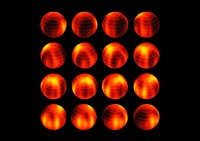Weather map of a distant world could shed new light on planets

Researchers have mapped the surface of a brown dwarf – an object larger than a planet and smaller than a star – for the first time.
Scientists say the methods used in their study could eventually be applied to examine small, cool planets in other solar systems.
The team of European scientists carried out a pair of studies to analyse the atmosphere of the nearest brown dwarf to Earth, known as Luhman 16B, some 6.5 light years from the sun.
Researchers found that Luhman 16B has a complex structure of patchy clouds made up of droplets of liquid iron and other minerals, with temperatures in the clouds exceeding 1000°C.
Novel techniques
The brown dwarf is too far away for direct images of its surface to be captured, so the team applied a number of novel techniques using two telescopes in Chile to analyse its atmosphere. As Luhman 16B rotates, bright and dark clouds move in and out of view and its brightness changes.
In one study, led by the University of Edinburgh and published in Astrophysical Journal Letters, the team observed changes in the brown dwarf’s brightness and were able to reconstruct what happens in different layers of its atmosphere.
In a second study, led by the Max Planck Institute for Astronomy in Germany and published in Nature, the team used an indirect imaging technique to directly map out a layer of clouds.
“We are excited by what we have been able to see in these studies, but this is only the start. With new generations of telescopes, such as the forthcoming European Extremely Large Telescope, astronomers will likely see surface maps of more distant brown dwarfs – and eventually, surface maps for young giant planets.” Dr Beth Biller, now Institute for Astronomy, who led the second study.
Video
Zooming in on the nearby brown dwarf Luhman 16B
Flying among the closest stars to the Solar System

